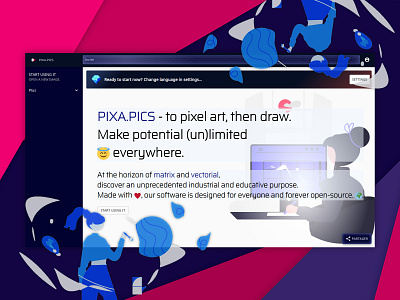Pixa.Pics - To pixel art, then draw.
Pixel Art and its origin
Some of the earliest known examples of computer-generated algorithmic art were created in the early 1960s. Pixel art, instead, as it is known today largely originates from classic video games, particularly those born in the early 1980s as we can name "Space Invaders".
During the 1990s, the widespread availability and accessibility of video games and the advancement in the techniques for pixel manipulation allowed for professional graphic designers to call it the "Golden Age of Pixel Art".
The definition of pixel art has been a constant subject of discussion between artists. In general, it is characterized by the importance that is placed in each pixel of an image by the artist. Therefore, an image in which the pixels are visible and discernible from one another, but were not placed with intent or coordination, such as in a low resolution photograph, is not necessarily considered pixel art.
To try and achieve this minimalist aesthetic, most works of pixel art are also restrictive in file size and the amount of colors used in their color palette, some only using a palette of two colors (1-bit color depth). Because of this, pixel art presents strong similarities with a lot of traditional art forms such as mosaics and certain types of textile techniques (such as embroidery and knitting), whereby an artwork is produced out of a collection of identical units.
Blockchain and its NFTs
Now we can majorly quote the forced downgrade of visual graphics that a blockchain is capable of storing since the first blockchain developed by Satoshi Nakamoto emerged in 2009 letting this technology evolve into building "Smart Contract" and most recently the categorization of those into the name of "Non-Fungible-Token" for those who execute a specific behavior.
It is by constraints rather than by will that most NFTs are pixelated, it is in the desperate hope to be able to generate using a computer some set of pictures giving the same piece of entertainment embedded into a collection such as "Bored Ape Yacht Club" or again in the hope of storing thousands of aggregation of thousands image into a super-computer-state being replicated sometimes hundreds of time at separate worldwide locations and updated/synchronized every block created containing all the new transactions and contracts inside of it.
Privacy on the fly
With now nearly every government having to be able to deploy and deplore a plethora of threats and damages caused by surveillance, initially against money that the state can't use and most idiomatically war, again including the war on terror; the super-advanced computers of big near private data-center, collect and analyze, luminously, a millisecond per millisecond at a time, each data they catch from what passes through their territory of the web including your data, sometimes bringing Internet-Super-Power into conflict with governments for the value theses data are to them sometimes nearly a gift.
And foremost, every information you decide to publish on the Internet can be copied and stored in a manner that it can outlive you, and get beyond the intent you sue when dealing with the platform initially.
That's why, me and myself only, Affolter Matias, I decided to urge myself to create algorithms preserving the intent of the picture you want to play with, dealing to reduce it from many thousands of colors to a simple set of around twenty colors while preserving only the useful dimension of both height and width, to make pixel art accessible, and easily shared without scandals getting both lightness and benefice instead of harm and sacrifice for the Web 3.0 to see an emerging contact with reality and for it to see the light.
The algorithm takes the color palette and the count per color, then it merge all that hasn't been merged following classical color merging in information technology through a threshold and merge both color at weight for “color_2”: “color_2” / “color_1 + color_2” and about the same for the first color threshold in order to replace both color in the palette. It takes near “color_length color_length” to process so it first makes a rounding / padding to a near simpler color depending the threshold of color merging you ask it… This algorithm merging colors by redundancy hasn’t been seen in real-life yet, it is yet very heavy to process for current CPUs as of 2022.
Features of https://pixa.pics/
* 1 smart import feature with fancy resizing and color reduction algorithms (Designed and developed exclusively for it)
* 1 powerful system of layers
* 16 Painting tools
* 23 Selection tools
* 12 Effects (color tuning)
* 24 Filters (color correction)
About Me
Passionate about stars, cryptography, and computer, I began following a particular interest in 2D/3D visual effects when I was in school to then study some years IT in an organization of public interest where I had to learn Web, Networking, and others useful pieces of stuff I used to develop projects in the field of blockchain technology with the help of my family including my father and my friends.
Philosophy is the science of estimating value, but technology is the value of estimating science. All that we perform in IT is described for humans and encoded for a machine, compassion, and vigilance are required to code along with knowledge.
-Affolter Matias
---
Feel free to share or ask us something.
